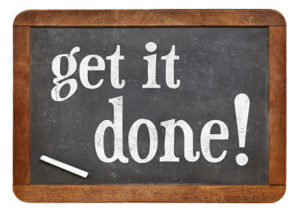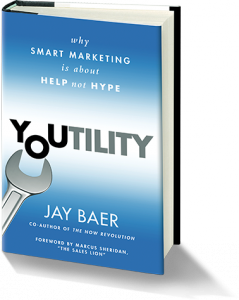Five Ways to Get it Done
October 12, 2016
 How do you get it done? If I ask any marketing pro, business leader or entrepreneur what they need more of (and I take money out of the list of possible answers) 99% of them will give me the same response.
How do you get it done? If I ask any marketing pro, business leader or entrepreneur what they need more of (and I take money out of the list of possible answers) 99% of them will give me the same response.
Time.
Whether it’s the pace of life, the vast variety of channels, information overload or that most companies are getting by with fewer people – everyone is time starved. I believe that the popularity of many of our modern conveniences is simply a result of our never-ending hunger for just a little bit more time.
The alternate title of this column could have been “live every day like you’re going on vacation tomorrow.” I marvel at how much I get done in the 48 hours before I leave for vacation. It’s practically magical how the To Do list relinquishes itself to me. I’ve learned to harness some of that pre-vacation magic to get it done and here’s how you can too.
One list, one focus: I’m not so sure Post-it Notes are our friend. It’s so easy to jot something down as a reminder to get it done and next thing you know, you’ve got a Post-It Note panorama on your desk, monitor or taped into a few notebooks.
To truly get more done – capture everything you need to accomplish in one place. Whether it’s a smartphone app or old-fashioned pen and paper – have a master list that you can trust is complete.
Once you have your master list, chunk like chores together. It’s much more efficient to make five phone calls in a row than piecemeal them out throughout the day. You get in a groove and shifting in and out of the groove takes time and energy you don’t want to waste.
Declare a deadline: The reason the pre-vacation thing works is because you have a hard and fast deadline. You can use that psychology to your advantage on a regular basis. You need to create your own deadlines and build in accountability by telling co-workers, friends or whoever is going to hold you to it. If you have to – create a consequence for missing the deadline. The more public the deadline/consequence, the more effective it will be.
Know your rhythm: Odds are the things on your To Do list aren’t new experiences. You’ve done most of them before, and you know what they require of you. If you write better in the morning, make sure you get all the writing tasks done before noon. If you get a little sleepy/lazy mid-afternoon, do something that revs you up in that time slot. Everyone has their own rhythm, so cater to yours to maximize each minute.
Protect your time: When you’re going on vacation, it’s so much easier to say to that chatty co-worker “Sorry but I have to get this report done before vacation.” You need to learn how to do that every day. Depending on how and where you work, – that might mean closing the door, coming in early, or working from home for a couple hours. But do it every week, and you will be amazed at how much more you get done.
Block the shiny objects: Email, Facebook, the conversation in the hallway, or that junk drawer that is begging to be cleaned. When you’re feeling overwhelmed, it’s easy to give in to whatever shiny object is in front of you. You need to outsmart the shiny objects by blocking their access. Turn off that email ping, that Facebook stream and anything else that tempts your attention.
Imagine it – if you treated every week like it was your pre-vacation week, you’d tear through your tasks. You might even get enough done that you could actually not work on your real vacation … once you take it!
More






 Let’s look at the reality:
Let’s look at the reality:
 We have to remember that every day, both our existing customers and potential customers are looking at us and wondering “why would I pick you?”
We have to remember that every day, both our existing customers and potential customers are looking at us and wondering “why would I pick you?”
 When you’re creating any sort of communication aimed at a potential buyer, you want them to do what?
When you’re creating any sort of communication aimed at a potential buyer, you want them to do what?